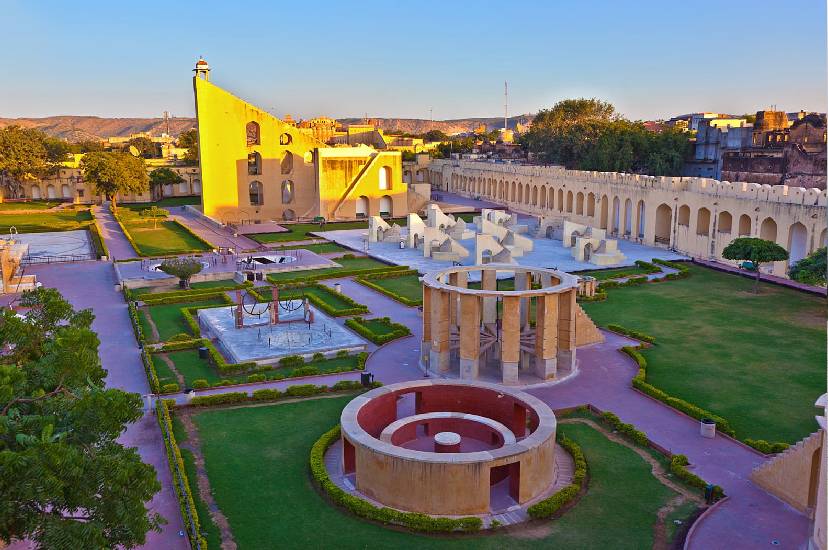Jantar Mantar, Jaipur

A set of 14 huge astronomical instruments which stands now as a complex of mastery in architecture, the Jantar Mantar Observatory in Jaipur is one of the major attractions of its own kind. This beautiful complex is built by Maharaja Jai Singh II with a view to helping him to predict his fate in the wars which are going to come. Presently, Jantar Mantar is famous for its cunning use of geometrical designs in the form of instruments. This majestic palace is located in the heart of the pink city known as Jaipur and has the power to attract so many visitors from all over the world for good reason. Regarded as a World Heritage Site by UNESCO, Jantar Mantar in Jaipur city attracts many architects, mathematicians, historians, and geographers. Jantar Mantar is an amazing illustration to watch out the universe, beliefs, and societies together. It gives the importance of the technical intelligence of the medieval period. Just check out some list of things which will tell you why Jantar Mantar is such a marvel to explore.
Things to Observe
- There are 19 large instruments in the Jantar Mantar Palace each following a very specific purpose. The detailed information of the instruments in Jantar Mantar are as follows-
- Chakra Yantra is the instrument which provides the position of the sun at four different times during the daytime.
- Dakshin Bhitti Yantra is the instrument which measures the altitude, meridian, and zenith of the celestial bodies.
- Digamsha Yantra is the instrument used to predict the timings of sunrise and sunset.
- Dhruva Darshak Pattika looks out for the location of the pole star according to the position of other celestial bodies.
- The instrument known as Jai Prakash Yantra maps the reversed side of the sky and allows one to walk through the instrument and look out the changes.
- Kapali Yantra is useful to calculate the position of equatorial systems and that of celestial bodies too.
- Kranti Vritta Yantra is helpful in measuring the latitude and longitude of celestial entities.
- Laghu Samrat Yantra is the smaller version of the biggest sundial instrument.
- Rama Yantra which is a double cylinder instrument has the capacity to measure the celestial bodies, altitudes, and positions.
- Shastansh Yantra which is a 60-degree arc containing in a chamber is helpful to measure the diameter and distance of the sun.
- Unnatasha Yantra is a metal ring which gets separated itself into four segments assisting it to measure the distance and altitude of celestial bodies.
Tips for the Traveller
- Wear comfortable shoes which will allow you to walk with ease around the large structure and watch out the instruments properly.
- Dress up yourselves with loose and comfortable clothing as you need to walk a long distance to explore this place.
- You are permitted to do photography here but have to pay some charges for the same.
- The duration to explore Jantar Mantar will take approximately one hour which is enough for the visitors to look around for other tourist destinations as well on the same day.
Most Important Aspect of Jantar Mantar
The light and sound show at the Jantar Mantar definitely give a meaning to your time. It gives you information about the history of Jaipur city and why this amazing complex called Jantar Mantar was built. The different colors and creative narration will force you to admire the beauty of this scientific instrument. This place is perfect for couples along with the City Palace and Hawa Mahal. You can simply go for a walk around the market and do some shopping while you wait for the show timings. If you are planning to explore the Jantar Mantar, do connect to the Tusk Travel and take the benefits of this tour to this spectacular destination. Get your holidays refreshed on this exciting trip.
Operating Timings
You can visit this place from Monday to Friday and the timings are from 9 am to 4.30 pm.
Best Time to Visit
Exploring the Jantar Mantar in the mid-day is most preferable. During this time, the sun will be right at the top of your head and therefore you will be able to understand in what way the readings are taken for each and every instrument.
Entry Fees and Other Charges
- You have to pay Rs. 40 if you are an Indian adult or a child and Foreign tourists will be charged with Rs. 200 whether he is an adult or a child. The entry fees for Indian students is Rs. 15 per person and for International students, the cost is Rs. 25. Students can avail this discount by showing a valid ID proof.
- You can purchase tickets to explore the Jantar Mantar either online or at the entrance. There is also a light and sound show which gives you refreshment and for this purpose tickets have to be bought at the monument
How to Reach
This astronomical observatory is situated in the heart of the Jaipur city and is a walking distance from the City Palace. If you are traveling by air, then Jaipur International Airport is the nearest airport of about 12 km to reach this place. Check out the closest railway head called Jaipur Railway Station which is about 5 km only. Jaipur is well connected to other major cities like New Delhi, Kota, Agra, Bikaner, Mumbai and Baran by road also.
Guides That are Available
A guide is very essential when you plan to visit this place due to its richness in science and history. Guides are available for you only on request. Hire local guides for Rs. 200 and Rs. 150 will be charged for an audio guide. The audio guides which are available there will guide you properly with the significance of each structure and provides you with background about astronomy. If you are very keen on the movement of the heavenly bodies then you need to spend two hours at this place with the audio guide. The camera fees are Rs. 50. The guides will help you to get more detailed information about this amazing destination.
Restaurants near Jantar Mantar
- The Palace Cafe Restaurant
- The Tattoo Cafe
- Midtown Multicuisine Restaurant
- Heritage Buffet
- Shree Gopi Pavitra Bhojnalaya
- Samrat Restaurant
- Kabul Chicken Sajji
- The Grill Restaurant
Nearby Attractions
- Check out City Palace in Jaipur which lies right across from Jantar Mantar, including Hawa Mahal, Albert Hall Museum, Amber Fort, Ram Niwas Bagh and many more.
- Swargasuli tower, Chandpol Bazaar, Tripolia Bazaar, New Maharaja Gem Palace, etc. are the famous tourist spots around the main city areas of Jantar Mantar.
- Check out some other nearby attractions which include Maharaja Sawai Man Singh II Museum, Moti Dungari Temple, Heritage Textiles, Johri Bazaar, and Nahargarh Fort.
Conclusion
With Jaipur’s huge history, awareness of the measurable and sharp minds of the families of royal status can be obtained by architecture and construction. Jantar Mantar is one such illustration of the brilliance of the Jaipur rulers and nearby regions of Mewar, who paid a lot of attention in detailing the architecture of their kingdoms. This amazing complex is famous for the monument fort, fortress history, and culture.



